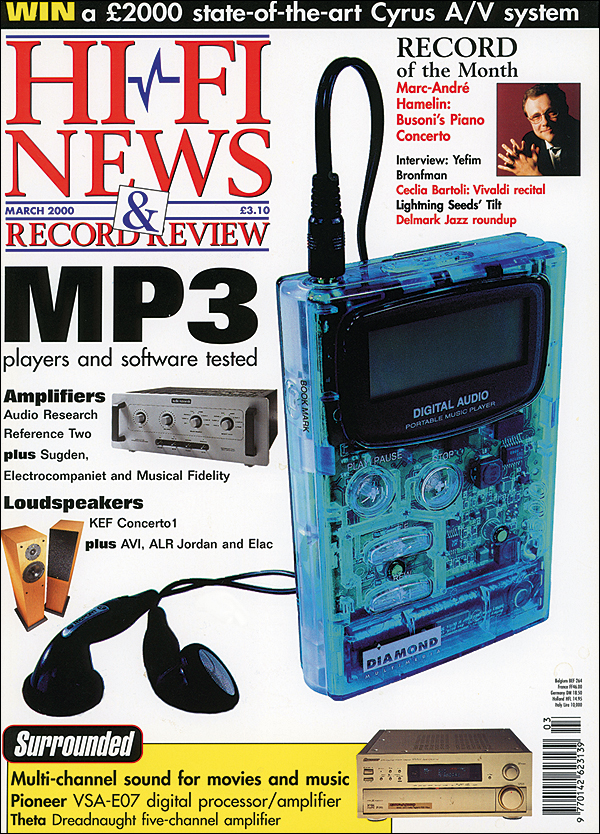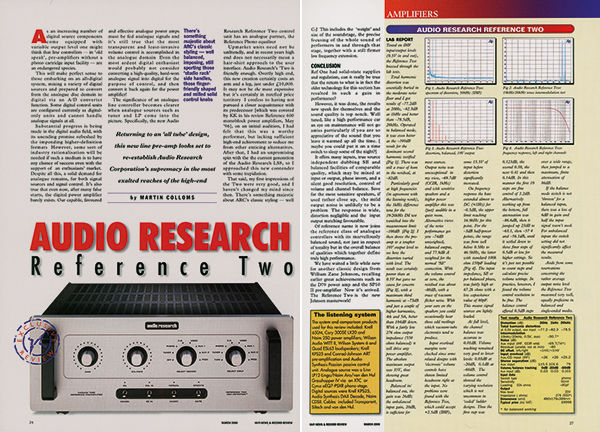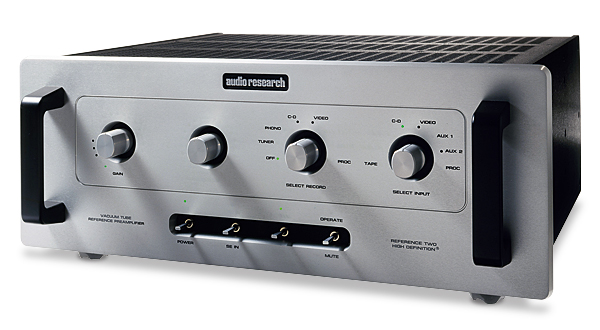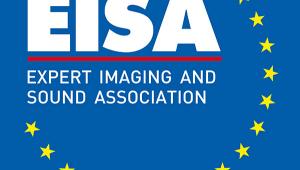ARC Reference Two

 Martin Colloms wonders if this all-tube line preamplifier can re-establish Audio Research's supremacy in the exalted reaches of the high-end
Martin Colloms wonders if this all-tube line preamplifier can re-establish Audio Research's supremacy in the exalted reaches of the high-end
As an increasing number of digital source components come equipped with variable output level one might think that line controllers – preamps without a phono cartridge input facility – are an endangered species. This will make sense to those embarking on an all-digital system, mixing a variety of digital sources and prepared to convert from the analogue disc domain to digital via an A/D converter function. Indeed, some digital control units are digital-only and cannot handle analogue signals at all.
Rack 'N' Roll
Despite all this, a solid demand for analogue remains, for signal sources and signal control too. Our highly capable, favoured and effective analogue power amps must be fed analogue signals, and it's still true that the most transparent and least-invasive volume control is accomplished in the analogue domain. Enter the Audio Research Reference Two line preamp.
There's something majestic about ARC's classic styling – well balanced, imposing, still sporting 'studio rack' side handles and those finger-friendly shaped and milled solid control knobs. The result is a tidy, no-nonsense look. On powering up, you are struck by the well-judged integration of the numerous but essential LED indicators, which clarify the functional condition. Tastefully all light green in colour, they are just the right brightness.

Remote controlled, of course, the unit comes with a slim handset that is functionally built rather than ostentatious, and whose facilities show the Two's versatility. First of all there's a standby condition and power-up, including activating the valves. There is independent control of sources for listening and for simultaneous recording, channel balance, absolute phase reversal and mute plus high resolution volume/'gain' control.
Looking at the back panel, this significant real estate is covered with audio sockets. Every input and output is available both in balanced format (XLR) and single-ended (via gold-plated RCAs). You can select from Phono (line level), Tuner, CD, Video, Aux 1, Aux 2, and 'Processor'. The latter is for a through signal, with its own level control. As the inputs are selected they may be assigned either balanced or SE input format, and these assignments are memorised until they're changed.
There's no 'hard' power switch – the mains input is instead via a detachable IEC connector. If the supply is removed the assignments will not be lost, even if the low power standby supply to the microprocessor is finally removed. This is because the memory contents will last up to a year without power.
The main volume control has 125 nominally 0.3dB steps, and the channel balance setting offers similar resolution. Nominal sensitivity is 125mV for an IHF 0.5V output (250mV, Aux 1). Noise is quoted as –97dB unweighted (re. 1V SE) while the frequency response claim is from 0.5Hz to 60kHz (–3dB points).

Technology
Creator and company founder William Z Johnson and his team took a retro path with this design, returning to his tube roots. As such, the Reference Two is packed with valves, the easy-to-replace and comparatively inexpensive E88CC /6922. A couple of much larger glass envelopes are also present, these belonging to the 6L6GC regulator and the 5AR5 rectifier valves. Yes, the main voltage supply for this design has all valve electronics. Audio Research rates the tube life for well-maintained sound quality at 4000 hours, about four years for an averaged 20 hours of use a week.
The amplifier consumes around 110W of power and in a critical installation could conceivably be left powered-up more or less permanently except for holidays! Expect to change the glassware, the supply and nine 6922s more frequently. They do last a bit longer left on all the time so a six-to-eight-month replacement cycle is then necessary, like a major service of your car. High hysteresis polymeric ring dampers are fitted to all the small signal valves to reduce the effect of any residual microphony.
Inside, the supply section begins with two toroidal power transformers located well away from the signal amplifiers, plus a small isolating transformer to independently run the microprocessor and digital logic. In addition to the full-wave tube rectification and regulation there's a bank of frequency-graded reservoir capacitors made up of Nichicon electrolytic and polypropylene film caps, 'Rel' and Multicaps.
Built in a strong aluminium alloy case, the unit contains four full-width, vertically orientated printed circuit boards. The control section is at the front, all logic, complemented by the matching remotely controlled interface driven via the microprocessor. Second is the power supply board, third is the amplifier proper and board four is entirely passive, interfacing directly to the input/output connector array and carrying the selector relays.

The input signal is then led to a ladder of precision resistors, balanced for the two channels, with controlled attenuation/volume control achieved by the programmed selection of logic-controlled silicon chip resistors.
Still DC-coupled, the signal continues to the differential, balanced triode amplifier section, which consists of a total of eight selected triodes per channel. Employing cross coupling for good differential operation for both SE and balanced working, FET current sources help achieve good matching and fine common mode rejection.
Parallel Lines
In traditional Audio Research style, the output capacitors are included in the feedback loop, and they are elaborate combinations of polymer film caps: 4µF, 0.68µF and 0.01µF in parallel, four sets in all. Negative feedback is just sufficient to stabilise gain, bandwidth and output impedance. In contrast to rival designs, the types used by Audio Research are powerful load-drivers with a very extended low-frequency performance. Build quality is excellent, so a long operating life is certainly likely.
Take A Stand
With tube equipment, there can be a greater sensitivity to siting due to vibrational microphony effects and also with cables, particularly at the output. There can be unexpectedly large changes in character and overall performance with cable even at the highest level. If I hadn't been forewarned by my earlier experiences with Audio Research and other tubed preamps, I could easily have got the Reference Two wrong. I found that a good audio stand – essential for an analogue turntable or a class-winning CD player – was also a vital constituent so far as a good Reference Two installation was concerned. The overall gains in both clarity and image depth were truly significant in the context of this controller's potential achievement.
Another issue concerned mains power. Again a clean, low impedance connection seemed to lower the noise floor, allowing deeper, longer reverberant decays to be heard after notes had ceased. After transportation, even after a run-in period, the tubes need a few days to settle down again, which proved to be a worthwhile wait in my opinion.



















































